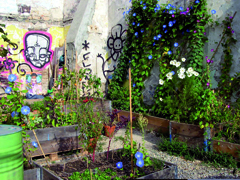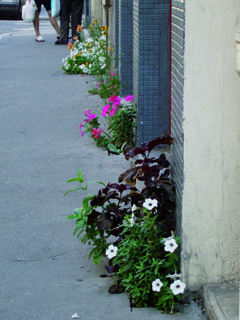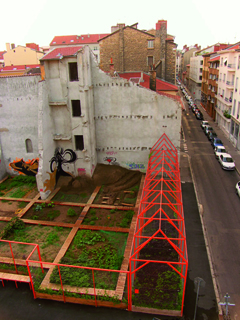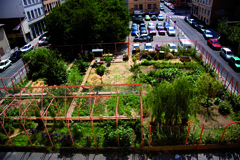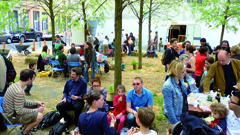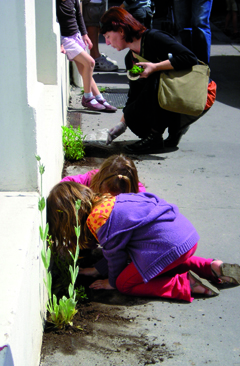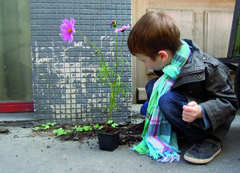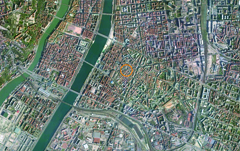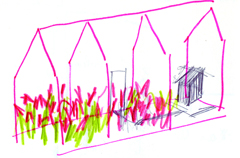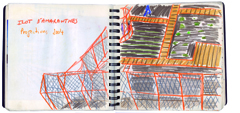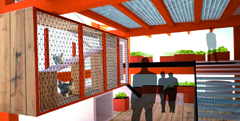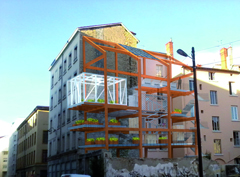Îlot d'Amaranthes
Exhibit Category / Catégorie de l'expo: Community & Knowledge
Location/Emplacement: 52, rue Sébastien Gryphe - Lyon 7e - France
Dates: 2004 - present
Designers/Concepteurs: Emmanuel Louisgrand, Galerie Tator
Clients: Association Brin’d’Guill
More Information/Plus d'informations: n/a
Image Credits/Crédits d'images: Georges Boichot & Emma Lidbury
Project Description: (version française ci-dessous)
The garden of l’îlot d’Amaranthes is in the heart of Guillotière, the result of an extraordinary collaboration. Designed in 2004 by the artist Emmanuel Louisgrand, the project is supported by Tator Gallery, an organization founded in 1994 by two designers to create a place of artistic investigation and experimentation. The idea, born in 2003, was to build a shared garden on nearby land owned by Greater Lyon, abandoned after a failed building project. The idea was to provide a symbolic space that would evolve and would accompany urban and environmental developments of the district while maintaining a graphic line characterized by its orange colour, texture and material. Thus, the garden, that originally looked like a greenhouse made of orange metal tubes and lush vegetation, was gradually transformed into an ordered garden consisting of small plots around a path. In 2007, a building adjacent to l’îlot d’Amaranthes was destroyed, allowing a new configuration of space. This allowed for easier cultivation through the construction of a terrace. Weeping willows were planted recently in the last vacant space of this extension.
The garden has been managed since 2005, by the association Brin Guill‘, an offshoot of the district council in accordance with the gallery. Founded to create green spots on an ad hoc basis in this very dense area, Brin Guill’s brownfield site was transformed into a kitchen garden. In 2006, in parallel with their experience with l’îlot d’Amaranthes, the association launched the Operation of Petits Brins Zurbains, accompanied by a “Design and Testing” group of the Green Spaces Directorate of the City of Lyon. The idea was to enable a greening of streets, making “micro floral settlements” with Green Spaces engaged in digging the sidewalks and giving advice. Thus, gardening brownfields extended to the street.
Browse for more projects in the Carrot City Index.
Description du Projet:
Le jardin de l’îlot d’Amaranthes est au cœur du quartier de la Guillotière, le résultat d’une collaboration hors de l’ordinaire. Conçu en 2004 par l’artiste Emmanuel Louisgrand, le projet est porté par la Galerie Tator, fondée en 1994 par deux designers pour créer un lieu d’investigation et d’expérimentation artistique. L’idée, née en 2003, était de constituer sur un terrain avoisinant appartenant au Grand Lyon, délaissé après être voué à être construit, un jardin partagé, pour redonner une symbolique à cet espace par une œuvre non pas figée mais évolutive, qui accompagnerait les évolutions urbanistiques et environnementales du quartier tout en gardant une ligne graphique caractérisée par sa couleur orange, sa texture et sa matière. Ainsi, le jardin qui ressemblait au départ, à une serre formée de tubes métalliques oranges et à la végétation luxuriante, s’est peu à peu transformé en un jardin ordonné constitué de petites parcelles autour d’un sentier. En 2007, un immeuble attenant à l’îlot d’Amaranthes est détruit, permettant une nouvelle configuration de l’espace. Ceci permet au jardin cultivable de prendre ses aises avec la construction d’une terrasse. Des saules pleureurs sont plantés récemment, envahissant le dernier espace resté vacant qui constitue une dernière extension.
Le jardin est géré depuis 2005 par l’association Brin d’Guill’, une émanation du conseil de quartier, en accord avec la galerie. Fondée afin de créer des coins de verdure de manière ponctuelle dans ce quartier très dense, Brin d’Guill’ transforme des friches en jardin potager. En 2006, en parallèle avec son expérience aux Amaranthes, l’association lança l’opération des Petits Brins Zurbains, accompagnée par la cellule «Etude et essais» de la Direction des Espaces Verts de la ville de Lyon. L’idée est de provoquer une végétalisation des rues en faisant des «micro implantations florales», avec les Espaces Verts s’occupant de creuser le trottoir et donner des conseils. Ainsi, le jardinage des friches est passé à celui de la rue.
A la Guillotière, le jardinage devient un laboratoire de petites utopies citoyennes, où l’expérimentation environnementale va de pair avec la convivialité et la créativité. L’îlot d’Amaranthes, plus qu’une œuvre artistique, constitue un lieu de vie du quartier accueillant les structures et associations.
Trouvez d’autres projets avec l’Index de Carrot City.


